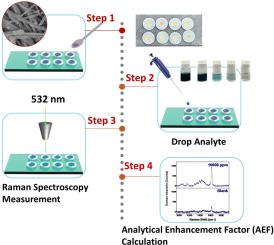自沉淀金属掺杂钛酸盐纳米纤维衬底用于有机分析物表面增强拉曼散射
IF 6.3
3区 工程技术
Q1 ENGINEERING, CHEMICAL
Journal of the Taiwan Institute of Chemical Engineers
Pub Date : 2025-09-16
DOI:10.1016/j.jtice.2025.106396
引用次数: 0
摘要
背景表面增强拉曼散射(SERS)已经成为一种强大的痕量探测技术,它利用局域表面等离子体共振(LSPR)来放大弱拉曼信号。虽然贵金属修饰TiO2作为SERS衬底显示出巨大的潜力,但传统的修饰方法如光沉积和湿化学通常耗时、昂贵且多步骤。为了克服这些限制,我们开发了一种直接的水热合成方法,用原位自沉淀的金纳米颗粒制备了掺金钛酸盐纳米纤维。该方法为增强SERS性能提供了一个可扩展、高效的平台,广泛适用于环境和工业污染物监测。方法采用水热法合成不同金属离子掺入量的钛酸盐纳米纤维。自沉淀金纳米粒子均匀地集成在钛酸钠纤维上,以增强表面等离子体共振行为。综合表征,包括同步加速器x射线衍射、XPS、UV-Vis、拉曼光谱和光辅助开尔文探针力显微镜(photo-KPFM),用于确认纳米颗粒成功整合并评估等离子体增强。重要发现:金掺杂钛酸盐衬底具有优越的SERS性能,在低至3.0 × 10−9 g/cm2的浓度下,亚甲基蓝检测的分析增强因子(AEF)达到185,000。研究结果表明,掺金钛酸盐纳米纤维是一种可扩展的、灵敏的有机污染物检测平台,在环境监测和分析传感方面具有潜在的应用前景。本文章由计算机程序翻译,如有差异,请以英文原文为准。

Self-precipitated metal-doped titanate nanofiber substrates for surface-enhanced Raman scattering of organic analytes
Background
Surface-enhanced Raman scattering (SERS) has emerged as a powerful technique for trace-level detection by leveraging localized surface plasmon resonance (LSPR) to amplify weak Raman signals. Although noble metal-modified TiO2 shows great potential as a SERS substrate, conventional modification methods such as photodeposition and wet chemistry are often time-consuming, costly, and multi-step. We developed a straightforward hydrothermal synthesis to fabricate Au-doped titanate nanofibers with in-situ self-precipitated Au nanoparticles to overcome these limitations. This method offers a scalable and efficient platform for enhancing SERS performance broadly applicable to environmental and industrial pollutant monitoring.
Methods
Various titanate nanofibers with different incorporated metal ions were synthesized via a hydrothermal method. Self-precipitated Au nanoparticles are uniformly integrated onto sodium titanate fibers to enhance surface plasmon resonance behavior. Comprehensive characterization, including synchrotron X-ray diffraction, XPS, UV–Vis, Raman spectroscopy, and photo-assisted Kelvin probe force microscopy (photo-KPFM) are employed to confirm successful nanoparticle integration and assess plasmonic enhancement.
Significant findings
The Au doped titanate substrate demonstrates superior SERS performance, achieving an analytical enhancement factor (AEF) of 185,000 for methylene blue detection at concentrations as low as 3.0 × 10−9 g/cm2. The findings establish Au-doped titanate nanofibers as a scalable, sensitive platform for organic pollutant detection with potential applications in environmental monitoring and analytical sensing.
求助全文
通过发布文献求助,成功后即可免费获取论文全文。
去求助
来源期刊
CiteScore
9.10
自引率
14.00%
发文量
362
审稿时长
35 days
期刊介绍:
Journal of the Taiwan Institute of Chemical Engineers (formerly known as Journal of the Chinese Institute of Chemical Engineers) publishes original works, from fundamental principles to practical applications, in the broad field of chemical engineering with special focus on three aspects: Chemical and Biomolecular Science and Technology, Energy and Environmental Science and Technology, and Materials Science and Technology. Authors should choose for their manuscript an appropriate aspect section and a few related classifications when submitting to the journal online.

 求助内容:
求助内容: 应助结果提醒方式:
应助结果提醒方式:


